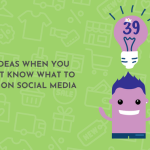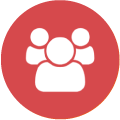Do you already have a customers database and visitors coming to your website?
Then creating a “Lookalike Audience” and then using Facebook’s remarketing and advertising options is something you should know about.
A Lookalike Audience is a way to reach new people who are likely to be interested in your business because they’re similar to your best existing customers. Read more about Lookalike Audience .
If you’ve heard anything or now visited the links above and educated about retargeting with Facebook’s remarketing tools, you’ve probably heard that it’s a valuable way for bringing visitors back to your website and content after they click on one of your ads or visit one of your tracked pages.
It’s a powerful way to reduce your advertising costs and increase your click-through rate by advertising to people who have shown an interest, however small, in your content, services or product.
Retargeting works very well for recapturing the interest of anonymous visitors to your site. Since you don’t yet have their contact info, typically you can’t nurture casual visitors into leads because you don’t have a way of following up with them. Facebook retargeting (as well as retargeting via other platforms) changes all that — it makes it possible for you to reconnect with visitors who checked out your pages by providing them new reasons to come back after they leave.
Retargeting is an incredibly valuable tactic for reaching those not on your list, it’s an even more high-yield method when used in combination with the contact information and customer data inside your CRM. Something magic happens when you combine the information you have in your CRM with Facebook’s advertising platform.
How is this possible? It’s all because of a little thing called “Facebook Custom Audiences.”
You can create a custom audience by importing a list of email addresses into Facebook. After you upload the email addresses Facebook will search it’s accounts that match those email addresses and create a Custom Audience that includes the exact people whose addresses you imported. The implications of this are major — you can target your leads and customers on an individual level based on interests and other behaviours, not just a keyword searched online.
Instead of just displaying ads to anonymous individuals who’ve been identified based on the targeting criteria from their Facebook account or online behavior, when you link Facebook with your database using a CRM or automation platform, you can unlock several additional benefits of retargeting:
- You can avoid displaying ads to your existing customers for products they already bought.
- You can use the unique information you have in your database to create additional new (cold) audiences that are similar to your existing customer base.
- You can send incredibly targeted ads to the contacts in your database based on behavioral and demographic information you have about them in your CRM.
- You can nurture new contacts into leads more effectively by displaying ads to them that match their position in your funnel, recommending additional content or introductory products that perfectly reflect the stage of their relationship with your brand.
How do Facebook Custom Audiences Work?
First, it’s important to understand how Facebook’s typical ad targeting for new (cold) audiences works. When creating an ad campaign on Facebook, advertisers can select the audience they want to display the ad to. Using Facebook’s Audience Insights tools, you can create your own audience of Facebook accounts by selecting targeting criteria based on information Facebook has collected about each of its users. This includes information about what pages they’ve liked or followed and what types of websites they have visited with a Facebook tracking pixel installed. (Yes, that’s right: Facebook knows where their individual users are spending time across the web, even off of Facebook’s domain.)
Custom Audiences take this targeting process to the next level — they allow advertisers to create an audience based on identifying users who have interacted with them in the past.
There are two different types of Facebook Custom Audiences:
- Website Traffic Retargeting: This method involves identifying Facebook users, via a tracking pixel, who have visited your own pages in the past and serving ads to those anonymous users to bring them back.
- List Upload Retargeting: This method creates a Custom Audience based on a list of email addresses that you upload into Facebook. It finds Facebook accounts associated with those emails, allowing you to target the exact people in your CRM.
The second method is what unlocks the possibilities of individual targeting.
Moving Contacts From Your CRM Into Custom Audiences
To get very narrowly targeted Facebook audiences that are up-to-date has traditionally involved creating groups within your database and exporting lists of contacts based on specific data points.
For example, you could create a list of everyone who has purchased your product so far and then import that list on September 1. But by October 1, there might be dozens of new customers, so you would need to export the list again and update your custom audience again.
Now, you can use automation to seamlessly manage your Custom Audiences based on any information about individual contacts stored in your account. For example, you could set up automation that always adds each new customer to your Facebook Custom Audience called “Customers.” That way, you never have to manage your lists and custom audience with exports. This method unlocks some serious opportunities for creating a multi-channel communication strategy for moving leads and customers through your funnels.
Leveraging the Power of Custom Audience Automation to Create Three Valuable Audiences
To make the most out of this incredibly powerful integration, here are three specific Facebook Custom Audiences that every business should have set up. As an added bonus, each one of these custom audiences can be easily managed with automation.
1. All Contacts Who Have Opted In (Prospects)
The first list you should set up and start leveraging is a list of everyone who has opted in on your landing pages or an online form.
You can use your “Opt-Ins” Custom Audience to achieve a few valuable objectives:
Avoid Targeting Those Who Have Already Opted In
One of the first things you should do is exclude this audience (that is, filter them out of the audience) for all of your other opt-in campaigns. They’ve already opted in; you don’t need them to do it again – so why pay for ads that ask them to? This is easy to adjust in your targeting options on Facebook’s platform. Simply make sure the audience you’re using for any campaign you’re running where the goal is to acquire contact information excludes the list of those whose contact information you already have.
Move Your Contacts Through the Next Steps of Your Funnel
Additionally, you can use this list of opt-ins to create highly specific campaigns that move your new contacts further through your funnel. After contacts opt in for a free ebook, a webinar or a coupon, your job is to get them to take the next big step. You can create a Facebook advertising campaign with a call to action that’s more of a commitment that you could show to a cold audience.
For example, you could promote a trial of your product or a free demo call with someone on your sales team. Just select your “opt-ins” custom audience when creating the campaign, and rest assured that only people who have engaged with you will be targeted with ads pushing them to take this significant next step.
If you want to get even more sophisticated with your retargeting campaigns toward opt-ins, you can segment your audiences based on content or product categories. To do this, you’d just create several different Facebook Custom Audiences and use rules to add new contacts to the audience that is specific to the reason they opted in.
For example, say you’re running a content marketing campaign for an upcoming event to attract leads for other services or products your offer. On your optin page(s) or from where they came you might have different services or products you want to promote later . If someone opted in for a lead magnet about that product or service, you could add them to your Facebook Custom Audience called “Opt-in: Product/Services Interest.” That way, you can retarget them with similar content to nurture them over time.
Or say that you’re an ecommerce retailer using cold campaigns to attract new shoppers. Your campaign might use product imagery to attract potential shoppers to your storefront, then a pop-up ad offering a free 20% off coupon for opting in to your email list would capture their information. You could divide your new opt-ins according to the product type that they showed an interest in.
For example, you would add anyone who came in because they clicked on an ad for T Shirts to a Custom Audience called “Opt-In: T Shirts Interest.” Then, you could retarget that particular audience with more advertisements for T shirts to drive them to make a purchase.
Use Opt-In Data to Target a More Focused Cold Audience
Finally, you’d be missing out if you didn’t use your list of opt-ins to create what’s known as a “lookalike audience.”
Basically, this tool allows you to create a much larger audience, based on a very small one, that includes more people who are similar to the small audience. Lookalike audiences are extremely helpful for finding additional cold advertising targets who are more likely to convert because they have traits in common with the people who have already converted. You can take the new lookalike audience that you’ve created based on the people who opted in and add that audience back to your original cold advertising campaign geared towards obtaining new contacts. This should result in a cheaper cost per conversion, since you are targeting a group of people that are “lookalikes” with the list you already have.
2. All Leads Who Have Interacted With You (Opportunities)
After you nurture your relationship with new contacts via email or highly specific retargeting campaigns, some of them will eventually move on to the next steps. At this point, you can use even more specific retargeting campaigns to reel them in and convert them into customers. Once customers take the “big step” that you are pushing your audience of opt-ins toward, you should remove them from the “opt-in” audience and add them to an “opportunities” audience. These are people who have indicated a serious interest in your business, whether by having a call with a sales rep, signing up for a demo or trial, or even purchasing an entry-level product.
It can be the outcome of a task for your team to speak with a lead, or it can be triggered by a purchase of a specific product. It can be triggered by almost anything in your account – just make sure it’s an action that indicates this lead is seriously ready to buy. When it is triggered, the lead will be removed from the “opt-in” audience and added to the “opportunities” audience. Your product-centric campaigns or special promotions geared toward customer acquisition will be aimed at this audience.
3. All Existing Customers
Once leads respond to your conversion efforts by making a purchase, you should add them to a Facebook Custom Audience specifically for customers.
This will save you money by allowing you to exclude them from ads for the product they’ve purchased. Plus, you can also use the same tactic of creating a lookalike audience based on this group to improve the performance of your cold campaigns. (There’s no better group to target than those who look like your existing customers.) The way you structure these audiences will be different depending on your business model.
Customer Audience for a Subscription-Based Business Model
If you sell a subscription product, such as a digital membership product or software, you should use automation to create a list of all your active customers making recurring payments, and maintain it over time as new customers are added and others cancel.
Simply add a step to your post-purchase automation that removes customers from the “opportunities” audience once they purchase and adds them to your “active customers” list. Then, add a step to your cancellation process that removes customers who cancel from your “active customers” list. You can add them to a “canceled customers” Facebook audience if you think it is worthwhile to run a campaign to bring them back, perhaps with a special promotion or to a different product.
Customer Audiences for Ecommerce Businesses
If you are an online ecommerce business with multiple products, for example a fashion retailer or a home goods store, you’d be wise to carve up your custom audiences into different categories depending on different products or product types.
That way, you can effectively upsell and cross-sell by advertising to your customers.
For example, you can create a campaign for people who have purchased a pair of shoes on your site in the past to come check out your latest shoe sale. Or, you can use information about specific product purchases to suggest relevant upsells and cross-sells.
For example, if someone purchased a sofa on your website recently, you could create a campaign promoting throw pillows and blankets and target it specifically to them. All you need to do to automate this is add a rule in the post-purchase process for a specific product that adds contacts to your corresponding Facebook Custom Audience.
With these three types of audiences, you can take your Facebook advertising to the next level to save money, earn more leads and sales, bring in new customers faster, retain them for longer, and even boost your revenue by upselling and cross-selling. Gone are the days of managing dozens of spreadsheets, imports and exports just to keep your Custom Audiences accurate and up-to-date. With the power of automation, you can manage it all as effortlessly as you manage the rest of your communications with leads and customers.
Are you using Custom Audiences on Facebook to target your leads or customers in a creative way that we didn’t cover here?
If Custom Audiences or Lookalike campaigns sounds like something your business should be exploring, please enquiry online or contact our team on 1800 QUBESOCIAL (1800 782 376).






 Reputation Management
Reputation Management Customer Voice
Customer Voice List Management
List Management Social Marketing
Social Marketing Online Advertising
Online Advertising Content Development (Copywriting)
Content Development (Copywriting) SEO & Visibility
SEO & Visibility Brand Analytics
Brand Analytics Website Design
Website Design Loyalty and Experiences
Loyalty and Experiences